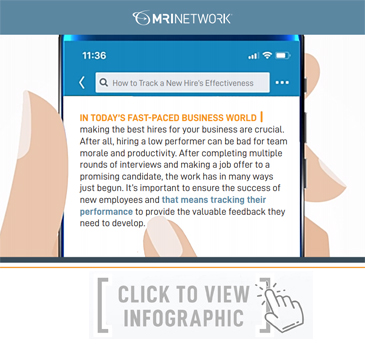After completing multiple rounds of interviews and presenting a job offer to a promising candidate, the work has in many ways just begun. Now that the new employee is starting at your organization, it’s crucial that you help ensure their success.
Before that process begins, you’ll also want to determine whether you can effectively track the productivity of that new associate. “Making the right hire is crucial for your business’ future,” says Kathryn Budd, director of human resources for MRINetwork. “That’s why tracking a new hire’s effectiveness is imperative – and something you should weave into your human resources process from day one.”
In fact, according to the 2019 MRINetwork Recruitment Trends Study, there’s one recruitment metric that stands out among the rest when trying to gauge a new hire’s effectiveness: performance tracking. Nearly half (48 percent) of employers said it was their top benchmark for assessing a new hire’s effectiveness.
Meanwhile, other factors include:
- Tracking the source of successful candidate hires (35%)
- Source and quantity of candidates who were offered a position (33%)
- Time to hire (32%)
- Interview-to-hire ratio (31%)
- Fall-off rates: new hires who accept offers, but don’t show up for the first day of work (27%)
What does performance tracking of a new hire mean? It’s the process of evaluating how well an employee is doing at your organization through a variety of strategies, tools and resources.
However, this isn’t always clear-cut. For example, according to a Forbes article written by CEO Robert Glazer, the definition of success can be murky. “Fit and performance remain gray areas for many business leaders,” he writes. “Situations arise where it’s clear that something has gone wrong, but no one is sure if the problem is with the employee or with management.”
That should never be the case at your business. “It’s extremely important to clarify your company’s definition of success for new employees,” says Budd. “That way, you can find and implement strategies to efficiently track performance.”
For instance, one study cited by Forbes found that “the process matters.” It continues that the performance review process “can be viewed as uncomfortable, unfair and uninspiring.” To help improve it and, “make sure employees accept the feedback, managers must acknowledge the individual identities of their workers and their specific contributions to the organization over time.”
Here are strategies to consider when tracking a new hire’s effectiveness:
1. Conduct performance reviews that are holistic and well-documented
The first way is through the performance review. According to a Chron.com article, written by financial writer Joseph DeBenedetti about the methods of tracking performance, “Standardized performance review sheets allow managers to track employees’ fulfillment of, and progression toward, operating objectives over time.” These can take into consideration both technical skills as well as information about a person’s interpersonal abilities.
However, you should also create a culture where employees, especially new hires, receive ongoing feedback and check-ins. This is especially important for younger talent. As one Forbes article on the transformation of worker feedback notes, “Ongoing reviews have been a better way … to stay on top of professional development and opportunities for improvement rather than talking about it once a year.”
Therefore, offer continuous reviews alongside the more standardized annual review to give employees the more regular feedback they need to succeed.
2. Take peer reviews into consideration to see how an employee works with others
Conducting peer reviews and appraisals is a second strategy to follow. You can conduct these by speaking with multiple employees and managers about the new hire’s work, reporting trend data from these conversations to “identify favorable and unfavorable patterns of behavior,” according to the Chron piece.
“Conducting 360-degree review procedures are important because they help give your talent the opportunities needed to truly thrive,” concludes Budd. “By setting these up, employees will have the tools they need to succeed from day one with your company, which will help your bottom line as well.”
Through these strategies, you’ll have a strong grasp on how your new hire is doing at work. This will greatly boost your organization’s efficiency as well as keep your company culture strong for years to come.
Editorial Contact
Nysha King
Media Relations Lead
Office: 215.372.1384
Email: nysha.king@mrinetwork.com


Connect with MRINetwork